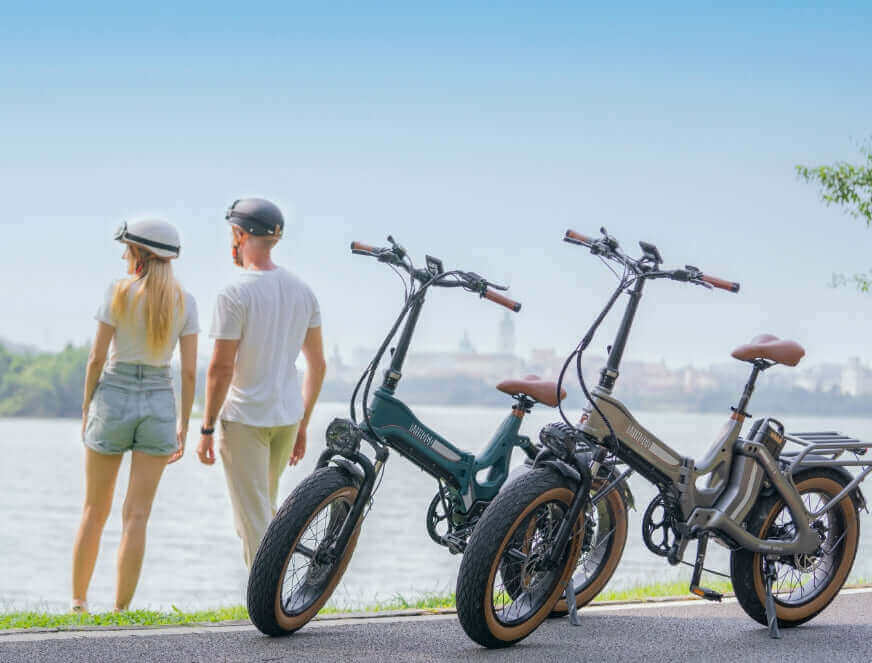Why Winter Storage Matters for Electric Bikes
Winter storage isn't just about keeping your e-bike clean—it's about protecting sophisticated electronic components from harsh conditions. Lithium-ion batteries are characterized by higher specific energy, energy density, and energy efficiency and a longer cycle life and calendar life than other types of rechargeable batteries, but they require special care during cold weather storage.
Key winter challenges for e-bikes include:
- Freezing temperatures affecting battery performance
- Moisture damage to electronic components
- Salt corrosion from winter roads
- Component degradation from prolonged storage
Essential Pre-Storage Cleaning and Maintenance
Deep Cleaning Your Mihogo E-Bike
Before storing your electric bike, thorough cleaning is essential. All Mihogo models feature IPX5 waterproof ratings or higher, making them resistant to water splashes from any direction, but avoid pressure washing.
Cleaning steps:
- Frame and components: Use a damp cloth and mild soap to clean the frame, paying special attention to the magnesium alloy construction found in models like the RX 2.4
- Battery contacts: Ensure all electrical connections are clean and dry to prevent corrosion
- Chain maintenance: Apply quality chain lubricant and rotate pedals to distribute evenly
- Brake inspection: Check hydraulic disc brakes (standard on Mihogo models) for proper function
Tire and Component Check
Inspect your e-bike's components before storage:
- Tire pressure: Inflate to recommended PSI (check sidewall markings)
- Brake pads: Assess wear on hydraulic disc brake systems
- Suspension: Test front suspension functionality (available on select Mihogo models)
- Display and controls: Clean the smart IPS display and ensure app connectivity works
Battery Storage: The Most Critical Component
Proper lithium-ion battery storage is crucial for maintaining your Mihogo e-bike's performance. Charge your lithium-ion battery to about 80% and then disconnect it. Store it in a warm, dry place away from direct sunlight.
Mihogo Battery-Specific Guidelines
For standard Mihogo batteries (48V systems):
- Remove battery from bike frame
- Charge to 60-80% capacity before storage
- Store at room temperature (15-20°C)
- Check charge level monthly, recharge if below 40%
For dual battery systems (Mihogo ONE, LX models):
- Store both batteries at similar charge levels
- Use the "Storage State" mode if available in your Mihogo app
- Store batteries in separate, dry locations
Temperature Considerations
Li-Ion cells will become compromised if stored below 0 degrees. We do not therefore recommend storing in a shed or garage over winter as temperatures in these areas can drop below zero. The ideal storage temperature range is 10-20°C (50-68°F).
Optimal Storage Location and Setup
Indoor vs. Outdoor Storage
Recommended storage locations:
- Heated garage or basement
- Spare room or utility area
- Climate-controlled storage unit
Avoid these locations:
- Unheated sheds or garages
- Areas with direct sunlight
- Damp basements or cellars
- Locations near heat sources
Storage Position and Protection
Proper positioning:
- Store upright using a bike stand
- Reduce tire pressure by 10-15 PSI to prevent flat spots
- Cover with breathable bike cover to prevent dust accumulation
- Ensure adequate air circulation around the bike
Foldable E-Bike Storage Advantages
Mihogo's foldable design offers unique storage benefits. Models like the Mihogo Mini can fold to suitcase size in just 10 seconds, while the RX 2.4 features quick-folding handlebars for compact storage.
Foldable storage tips:
- Fold according to manufacturer guidelines
- Store folded bikes on stable surfaces
- Protect folding mechanisms with light lubrication
- Keep folding latches clean and functional
Monthly Maintenance During Storage
Even during storage, your Mihogo e-bike needs attention:
Monthly checklist:
- Check battery charge levels (recharge if below 40%)
- Inspect for moisture or pest intrusion
- Rotate wheels to prevent flat spots
- Test folding mechanisms and electrical connections
Quarterly tasks:
- Deep clean if dusty
- Check tire pressure and adjust
- Test all electronic functions
- Inspect brake and gear cables
Spring Preparation: Getting Ready to Ride
When winter ends, proper preparation ensures safe riding:
Pre-Ride Inspection
- Full system check: Test motor, battery, and electrical systems
- Mechanical inspection: Verify brakes, gears, and tire condition
- Software updates: Check Mihogo app for firmware updates
- Safety equipment: Inspect lights, reflectors, and horn
First Ride Protocol
- Start with short, low-speed rides
- Test all assist modes and regenerative braking
- Monitor battery performance and range
- Check for any unusual noises or vibrations
Professional Maintenance Considerations
Consider professional servicing for:
- Hydraulic brake bleeding
- Motor diagnostics and software updates
- Battery capacity testing
- Comprehensive bike tune-ups
Advanced Winter Storage Tips
App and Technology Management
Mihogo's smart connectivity features require attention during storage:
- Keep app updated for remote monitoring
- Test Bluetooth connectivity monthly
- Ensure GPS tracking functions properly
- Review security settings and digital locks
Accessory Storage
Store removable accessories separately:
- Lights and electronic components
- Cargo racks and baskets
- Phone mounts and charging cables
- Safety equipment and gear
Environmental Considerations
Proper e-bike storage also supports environmental responsibility:
- Extends battery lifespan, reducing electronic waste
- Maintains optimal efficiency for eco-friendly transportation
- Preserves resale value for sustainable bike market
- Supports European green transportation initiatives
Conclusion
Proper winter storage of your Mihogo electric bike is essential for maintaining performance, extending component life, and ensuring safe spring riding. By following these comprehensive winterization guidelines—from battery care to cleaning protocols—you're protecting your investment in sustainable urban mobility.
Remember that each Mihogo model has specific requirements based on its unique features like dual battery systems, magnesium frame construction, or compact folding mechanisms. Always consult your owner's manual and consider professional maintenance for complex systems.
For more winter riding tips and maintenance guides, explore additional resources on battery technology and cold weather performance to maximize your e-bike experience year-round.
Ready to upgrade your winter commute? Explore our complete range of premium electric bikes designed for European riders at Mihogo EU Electric Bikes.






